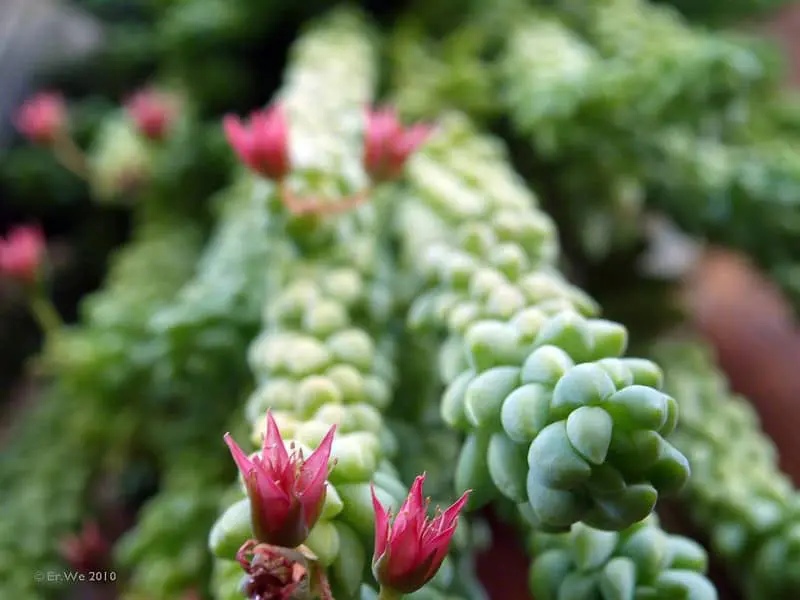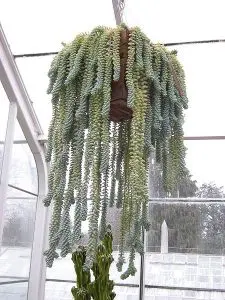This post contains affiliate links. If you buy something from one of our links we may earn a commission. Thanks

The burro’s tail plant (Sedum morganianum) is easy to care for and adds a touch of elegance to any room in your home.
Burro’s Tail Key Takeaways:
- The Burro’s Tail plant, known for its trailing stems and succulent nature.
- It thrives with proper care, including well-draining soil, bright indirect light, and moderate watering.
- Avoid over-watering and ensure a temperature range of 65-75°F for optimal growth.
- Fertilize monthly during the growing season.
- Consider propagation via stem cuttings to encourage fuller growth.
These succulents are known for their trailing stems and red flowers. They make fantastic hanging baskets.
These plants are also sold as donkey’s tail.
While they are basically low-maintenance plants, there are a few things you should know about how to care for them properly.
In this guide, we will cover everything you need to know about Burro’s Tail Plant Care from watering tips to propagation advice.
What Is A Burro’s Tail Plant?

The burro’s tail plant (Sedum morganianum) is a succulent native to Mexico.
It gets its name from its long, cascading leaves that resemble a donkey’s tail.
Burro’s tail plants are easy to care for and make a great addition to any home.
They are perfect for those who are new to plant care, as they are very forgiving.
Burro’s Tail Plant Care
Here is everything you need to know about Burro’s tail plant care!
Burro’s Tail Watering
Watering your burro’s tail plant is one of the most important aspects of care. These plants are native to arid regions and do not like to be overwatered.
How to water a burro’s tail plant
When it comes to watering your burro’s tail plant, the key is to let the soil dry out completely between waterings.
This succulent is native to arid regions of Mexico, so it is used to being in dry conditions.
Watering your plant too often will cause the roots to rot, so be sure to let the soil dry out completely before watering again.
If you are unsure whether or not the soil is dry, stick your finger into the soil. If it feels dry to the touch, then it is time to water your plant.
Another way to tell if your plant needs water is to look at the leaves. If they are starting to wrinkle, that means the plant is thirsty.
When you do water your plant, make sure to use room temperature water. Cold water can shock the plant and cause the leaves to drop off.
Water the plant thoroughly until the water runs out of the bottom of the pot. Then let it drain completely before putting it back in its spot.
Burro’s Tail Propagation
This is an easy plant to propagate and you can use stem cuttings or leaves to make more. Most people will use stems for this.
To propagate your burro’s tail plant, you can either take stem cuttings or leaf cuttings. For stem cuttings, take a cutting that is about four inches long and has several leaves on it.
Dip the cutting in rooting hormone and then plant it in moist well-draining cactus soil. Some people let it callus over before planting and rooting powder is optional.
Place the cutting in a pot of well-draining soil and water it lightly. Place the pot in a bright, sunny spot and keep the soil moist but not wet.
After a few weeks, you should see new roots growing from the bottom of the cutting. Once the roots are established, you can repot it and start watering your plant as usual.
The Benefits Of Burro’s Tail
The benefits of having a burro’s tail plant in your home are many. They are known to be excellent air purifiers, help to improve focus and concentration, and can even help to reduce stress levels.
Benefits Of Keeping Indoor Plants For Improved Lifestyle (indoorvegetablegrower.com)
If you’re looking for a plant that is both easy to care for and offers a multitude of benefits, then the burro’s tail plant is the perfect choice for you!
How To Care For A Burro’s Tail Plant When You First Get It
When you first get your burro’s tail plant, it is important to give it a good home. Choose a pot that is slightly larger than the one it came in and has drainage holes.
Fill the pot with well-draining cactus or succulent potting mix and water the plant thoroughly. Allow the soil to dry out completely before watering again.
In its natural habitat, the burro’s tail plant grows on rocky slopes and in crevices. To replicate this environment, use a fast-draining succulent potting mix.
Place the plant in a spot with bright indirect sunlight. Several hours of morning sun is great for it.
Water your burro’s tail plant thoroughly, then allow the soil to dry out completely before watering again.
This plant does not like to sit in wet soil, so be sure to empty any excess water from the saucer after each watering.
If the leaves start to wrinkle or drop off, this is a sign that the plant is not getting enough water.
Burro’s Tail Temperature
The burro’s tail is most comfortable with a temperature range of 65-75 degrees. So if you are comfortable your plant will be fine.
It can tolerate colder temperatures as low as 40 degrees for short periods of time.
But try to avoid putting it in hot or cold places inside the house like air conditioning or heating vents.
Fertilizing Burro’s Tail Succulents
Fertilize your burro’s tail plant once a month during the growing season with a cactus fertilizer or all-purpose succulent fertilizer diluted by half.
Be sure to flush the potting mix with clean water every few months to prevent salt buildup.
If you notice that the leaves of your burro’s tail plant are turning yellow or brown, this is a sign of either too much water or fertilizer. Cut back on watering and fertilizing until the plant recovers.
How To Make Burro’s Tail Fuller
The burro’s tail plant is a slow grower, so don’t be alarmed if it doesn’t seem to be growing much.
Just give it time and it will eventually start to fill out. If you want to encourage faster growth, you can propagate the plant by taking stem cuttings.
You can place stem cuttings directly back into the original pot to make it fuller.
Burro’s Tail FAQs
Burro’s Tail plants are a delightful addition to your indoor garden, bringing a unique aesthetic with their cascading leaves.
Though they are low-maintenance, understanding their care requirements will ensure they flourish.
Here are some frequently asked questions to guide you on the journey of growing and caring for your Burro’s Tail plant.
Q. How often should I water my Burro’s Tail plant?
A. Watering should be moderate, allowing the soil to dry out completely between waterings.
Over-watering can lead to root rot. It’s essential to check the soil’s moisture levels by touching it, and if it feels dry, it’s time to water your plant.
Q. What kind of soil should I use for my Burro’s Tail plant?
A. Utilize a well-draining cactus or succulent potting mix. You can also create your own mix by combining equal parts of perlite and coco coir.
Ensure the pot has drainage holes to prevent water accumulation, which could lead to root rot.
Q. How much sunlight does my Burro’s Tail plant need?
A. Bright indirect sunlight is ideal. Position your plant near a south or west-facing window.
Supplement with artificial light if natural light is insufficient. Aim for at least six hours of light exposure daily.
Q. How often should I fertilize my Burro’s Tail plant?
A. Fertilize your Burro’s Tail plant once a month during its growing season using a diluted cactus fertilizer or all-purpose succulent fertilizer.
Flushing the potting mix with clean water every few months helps prevent salt buildup.
Q. How do I propagate my Burro’s Tail plant?
A. Propagation can be done via stem or leaf cuttings. For stem cuttings, take a four-inch cutting, optionally dip it in rooting hormone, and plant it in moist well-draining soil.
Keep the soil moist but not wet, and place the pot in a bright, sunny spot.
Q. How do I prevent my Burro’s Tail plant from dropping leaves?
A. Ensuring proper watering practices, providing adequate light, and keeping the plant in a comfortable temperature range can prevent leaf drop.
Also, handle the plant gently as its leaves are quite delicate and can easily fall off with rough handling
Burro’s Tail Plant Care Final Thoughts
Overall, the burro’s tail plant is easy to care for and makes a beautiful addition to any home.
With proper watering and sunlight, your plant will thrive. Be sure to use well-draining soil and empty any excess water from the saucer after each watering.
Fertilize monthly during the growing season and flush the potting mix with clean water every few months to prevent salt buildup.
If you notice that the leaves are turning yellow or brown, this is a sign of overwatering or too much fertilizer.
We hope you enjoyed this guide on Burro’s Tail Plant Care. For more succulent and houseplant care tips, be sure to check out our other blog posts.
When it comes to burro’s tail plants, a little bit of knowledge goes a long way in helping them thrive.
By following the tips in this guide, you’ll be well on your way to becoming a plant care pro! Thanks for reading and happy growing!







